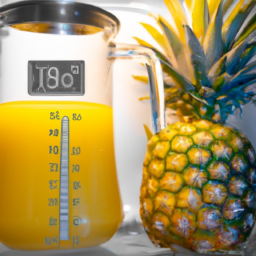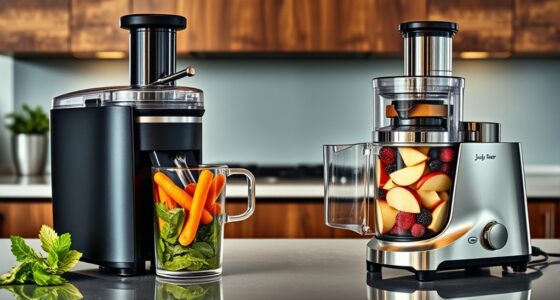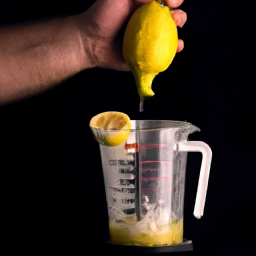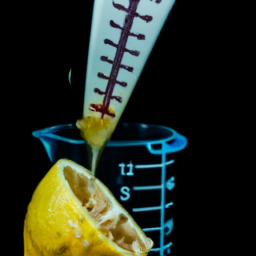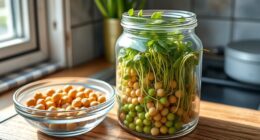As a cooking enthusiast, have you ever found yourself accidentally adding too much lemon juice to a recipe, causing it to overpower the other flavors? I have experienced this issue myself, but fear not, there are ways to rectify this common culinary mistake.
In this article, I’ll share some practical tips on how to balance out the acidity of too much lemon juice and save your dish.
First, it’s important to understand the problem with too much lemon juice. Lemon juice is highly acidic and can easily overpower other flavors, especially in delicate dishes. When this happens, the dish can become unappetizing and difficult to eat.
But with a few simple adjustments, you can salvage your meal and turn it into a delicious dish that is well-balanced and flavorful. Let’s dive into some solutions.
Key Takeaways
- Using lemon juice alternatives like lime, orange, vinegar, or white wine can balance out the sourness of lemon juice.
- Adding sweetness like sugar, honey, or sweet fruits can counteract the tartness of lemon juice.
- Diluting the dish with more ingredients like vegetables, fruits, or liquid can balance out the lemon juice.
- Using dairy products like milk, cream, or yogurt can neutralize the acidity of lemon juice and balance out the flavors in a dish.
Understanding the Problem with Too Much Lemon Juice
You’ve gone and squeezed too much lemon juice, haven’t you? Don’t worry, we’ve all been there.
The sourness of lemon juice can easily overpower a dish if not used in moderation. However, there are ways to fix this problem and salvage your meal.
One option is to use lemon juice alternatives. You can try using other citrus fruits like lime or orange, or even vinegar or white wine. These alternatives will still add the necessary acidity to your dish without the overwhelming sourness of too much lemon juice.
Another option is to balance the sourness with sweetness. Adding a pinch of sugar or honey can help counteract the tartness of the lemon juice.
To dilute your dish with more ingredients, you can add more of the other components of your dish to balance out the lemon juice. For example, if you added too much lemon juice to a salad dressing, add more oil or honey to balance it out. If you added too much to a marinade, add more water or broth to dilute it.
With these tips, you can fix the problem of too much lemon juice and still enjoy your delicious meal.
Dilute Your Dish with More Ingredients
Whenever I add too much lemon juice to a dish, I dilute it with more ingredients.
One effective way to do this is to add more vegetables or fruits, which not only balances out the tartness but also adds more nutrients to the dish.
Another option is to increase the amount of liquid in the recipe, whether it’s broth, water, or another type of liquid, to help dilute the acidity.
By doing this, I’ve found that I can salvage a dish that would otherwise be too sour to enjoy.
Add More Vegetables or Fruits
Wow, adding more vegetables or fruits to your dish is like a superhero swooping in to save the day from the overwhelming tang of lemon juice. Not only do they dilute the flavor, but they also add their own unique taste and texture to the dish.
Here are some ways to incorporate more vegetables or fruits into your meal:
-
Use juice alternatives: Instead of adding more lemon juice, try using other juices like orange, lime, or grapefruit. These juices have a similar tangy flavor but are less overpowering than lemon juice. You can also use vinegar or wine to add acidity to your dish.
-
Experiment with cooking techniques: Roasting or grilling vegetables and fruits can add a caramelized sweetness that balances out the sourness of the lemon juice. You can also try pickling or fermenting them to add a tangy flavor that complements the lemon juice.
By adding more vegetables or fruits, you not only fix the excess lemon juice problem but also add more nutrients and flavors to your dish.
Now, let’s move on to the next step of fixing too much lemon juice – increasing the amount of liquid.
Increase the Amount of Liquid
One way to balance out the tartness in your dish is by adding more liquid. This will help to dilute the acidity and create a more well-rounded flavor. You can use water, broth, or even a mild vinegar to increase the amount of liquid in your dish.
When adding more liquid, it’s important to keep in mind the ways to enhance flavor. For example, if you’re making a soup, adding more broth can help to balance out the tartness of the lemon juice, while also providing more depth to the overall flavor.
Additionally, if you’re making a sauce or dressing, you can use a mild vinegar like rice vinegar or apple cider vinegar to add more liquid and balance the acidity. By adding more liquid, you can create a more complex and pleasing flavor in your dish.
Now, let’s talk about how to add sweetness to balance the flavor.
Add Sweetness to Balance the Flavor
When I find my dish too sour due to too much lemon juice, I like to add sweetness to balance the flavor. My go-to options are honey or maple syrup, which add a natural and subtle sweetness without overpowering the dish.
Alternatively, I also like to incorporate sweet fruits such as mangoes or pineapples to achieve a similar effect. Adding sweetness is a simple and effective solution to fix a dish that’s too sour.
Add Honey or Maple Syrup
To balance out the excess lemon juice, you can add a teaspoon of honey or maple syrup, which will add a touch of sweetness to your dish. But did you know, which one is better for cooking – honey or maple syrup? Both honey and maple syrup are natural sweeteners that have their own unique benefits.
Honey has been used for centuries for its medicinal properties and is known to have antibacterial and anti-inflammatory properties. It also contains antioxidants that can help boost the immune system. On the other hand, maple syrup is a great alternative for those who are vegan or have a honey allergy. It contains fewer calories than honey and is a good source of antioxidants and minerals such as calcium and zinc.
| Honey | Maple Syrup |
|---|---|
| Rich in antioxidants | Contains fewer calories |
| Antibacterial and anti-inflammatory properties | Good source of minerals such as calcium and zinc |
| Contains vitamins and minerals such as iron and vitamin B6 | Vegan and allergy-friendly alternative to honey |
| Helps soothe sore throats and coughs | Adds a unique flavor to dishes |
If you have a sweet tooth, you can also use sweet fruits such as strawberries or blueberries to balance out the sourness of the lemon juice. Simply chop up your preferred fruit and mix it in with your dish. This will not only add sweetness but also a fruity flavor that complements the lemon.
Use Sweet Fruits
Get creative with your dish by incorporating sweet fruits like strawberries or blueberries to add a burst of flavor and balance out the tanginess of the lemon. Fruit substitutions are an excellent way to fix too much lemon juice in your recipe.
The natural sweetness of the fruit will counteract the sourness of the lemon. You can use any sweet fruit that complements the flavor of your dish. When using sweet fruits to fix too much lemon juice, you can also consider different sweetening techniques.
You can add a bit of sugar or honey to your fruit mixture to enhance the sweetness and reduce the acidity. Alternatively, you can use fruit juice instead of whole fruit to sweeten your dish. For example, if you’re making a lemon vinaigrette, you can add a bit of orange juice to the mixture to balance out the acidity.
With these sweetening techniques, you can easily fix the problem of too much lemon juice in your dish. Using dairy products to neutralize the acidity is another way to fix too much lemon juice in your recipe.
Use Dairy Products to Neutralize the Acidity
You’ll feel relieved to know that dairy products can come to your rescue if you’ve added too much lemon juice to your dish. The acidity of lemon juice can be neutralized by adding dairy products, such as milk, cream, or yogurt. Dairy products contain lactic acid, which can counteract the acidity of lemon juice and balance out the flavors in your dish.
To help you understand which dairy products to use, here’s a table that shows the benefits of dairy and some alternatives to dairy:
| Dairy Products | Benefits | Alternatives |
|---|---|---|
| Milk | Adds creaminess and richness | Soy milk, almond milk, coconut milk |
| Cream | Adds richness and thickness | Coconut cream, cashew cream |
| Yogurt | Adds tanginess and creaminess | Coconut yogurt, soy yogurt |
By adding the right dairy product to your dish, you can fix the problem of too much lemon juice and create a delicious, well-balanced meal. Now, let’s move on to the next section and learn about how to add spices to mask the lemon flavor.
Add Spices to Mask the Lemon Flavor
Spice up your dish with a blend of aromatic seasonings that’ll add depth and complexity to the flavors, transforming your meal into a culinary masterpiece.
When you’ve added too much lemon juice to your dish, one way to mask its flavor is by using different spice combinations. You can choose from a wide variety of herbs and spices that complement the dish you’re preparing.
For instance, if you’re making a fish dish, you can add a blend of dried herbs such as thyme, oregano, and basil. Alternatively, if you’re cooking chicken, you can use a blend of paprika, cumin, and coriander to add a smoky and earthy flavor. Experiment with different spice combinations until you find the perfect one that masks the lemon flavor.
Recipe examples can also be found online or in cookbooks to help with your spice combination selection.
To add umami flavors to enhance the dish, you can also use ingredients such as soy sauce, mushroom powder, and anchovy paste. These ingredients will add a savory and rich flavor to your dish, balancing out the acidity from the lemon juice. As you add umami flavors, be sure to taste the dish and adjust the seasoning accordingly.
With a little experimentation and creativity, you can turn a dish with too much lemon juice into a flavorful and satisfying meal.
Add Umami Flavors to Enhance the Dish
So, if you’ve added too much lemon juice to your dish and you’re struggling to balance out the flavors, here are a couple of tips that have helped me.
First, try adding some umami flavors to the dish. My go-to options are soy sauce or fish sauce. These ingredients add a savory depth to the dish that can help balance out the tartness of the lemon.
Another option is to add mushrooms or tomatoes, which both have a naturally umami flavor and can help enhance the overall taste of the dish.
Use Soy Sauce or Fish Sauce
Adding soy sauce or fish sauce to your dish can help balance the overwhelming flavor of too much lemon juice. Soy sauce is a popular choice because of its versatility and ability to add depth of flavor to any dish. On the other hand, fish sauce adds a unique umami flavor that pairs well with seafood and Asian cuisine. When choosing between soy sauce and fish sauce, consider the flavor profile of your dish and which sauce would complement it best.
To use soy sauce or fish sauce to fix too much lemon juice, start by adding a small amount and tasting as you go. Remember that both sauces are salty, so be cautious not to over-salt your dish. Additionally, try to use low-sodium versions to control the saltiness. Another tip is to mix in a small amount of brown sugar or honey to balance the savory flavors and add a touch of sweetness.
Overall, adding soy sauce or fish sauce can help salvage your dish and create a well-balanced flavor profile.
If you’re not a fan of soy sauce or fish sauce, another way to balance out the lemon juice is to add umami-rich ingredients like mushrooms or tomatoes. These ingredients have a natural savoriness that can help tone down the acidity of the lemon juice. Sauteed mushrooms or roasted tomatoes can add depth and complexity to your dish while also providing a counterbalance to the lemon juice.
Experiment with different ingredients and flavor combinations to find the perfect balance for your dish.
Add Mushrooms or Tomatoes
To balance out the overpowering sourness of too much lemon juice, incorporating umami-rich ingredients like mushrooms or tomatoes can do wonders for your dish.
Mushrooms are a great option as they’re packed with umami flavor and have a meaty texture that can add depth to your dish. You can try adding sautéed mushrooms to your pasta or risotto dishes, or even try out mushroom recipes like stuffed mushrooms or mushroom stroganoff.
Tomatoes are another great option as they can add a sweet and tangy flavor to your dish and can help balance out the acidity of the lemon juice. You can try adding chopped tomatoes to your salads, soups, or even try tomato-based dishes like spaghetti bolognese or tomato soup.
Incorporating these umami-rich ingredients will not only help balance out the flavors in your dish but will also add more depth and complexity to your overall taste experience.
To further thicken your dish and bring it all together, the next step is to use starches.
Use Starches to Thicken the Dish
You can easily thicken your dish by using starches like cornstarch or flour, which will also help balance out the overpowering lemon flavor. Here are some tips to effectively use starches for thickening your dish:
-
Mix one tablespoon of cornstarch with one tablespoon of water until it forms a smooth paste. Gradually add the paste to the dish while stirring constantly. Allow the mixture to simmer for a few minutes until it thickens.
-
If you prefer using flour, mix one tablespoon of flour with one tablespoon of butter or oil to create a roux. Add the roux to the dish while stirring constantly. Allow the mixture to simmer for a few minutes until it thickens.
-
Be sure to use a small amount of starch to begin with, as adding too much can result in a gummy or starchy consistency.
-
If you prefer a gluten-free alternative, you can use arrowroot powder instead of cornstarch or flour.
Now that your dish is thickened, it’s time to adjust the seasonings to ensure that the lemon flavor is balanced.
Adjust the Seasonings
So, I’ve added too much lemon juice to my dish, and now it’s too sour. What can I do?
Well, one way to fix it is to adjust the seasonings. Adding a pinch of salt or pepper can help balance out the acidity. Additionally, using other herbs or spices, such as garlic, thyme, or cumin, can add depth and complexity to the flavors and help mask the sourness.
Add Salt or Pepper
First, if you’ve added too much lemon juice to a dish, adding a pinch of salt or pepper can help balance out the flavors. The benefits of adding salt or pepper with too much lemon juice is that it can help counteract the sourness of the lemon, while also enhancing the other flavors in the dish. It’s important to remember that balancing flavors in cooking is key to creating a delicious and well-rounded dish.
To help you understand how much salt or pepper to add, here’s a table to refer to:
| Dish Type | Salt/Pepper Amount |
|---|---|
| Soup | 1/4 tsp per serving |
| Salad | 1/8 tsp per serving |
| Meat | 1/2 tsp per pound |
| Pasta | 1/4 tsp per serving |
Using this table as a guide, you can add the appropriate amount of salt or pepper to your dish and taste as you go until the flavors are balanced. If you still find that your dish is too sour, the next step would be to use other herbs or spices to complement and balance out the lemon flavor.
Use Other Herbs or Spices
Enhancing the flavor profile of a dish can be achieved by incorporating an array of herbs and spices. When it comes to fixing a dish with too much lemon juice, adding herbs or spices can help balance out the flavor. But which works best, herbs or spices?
Herbs are typically the leaves of plants, while spices come from other parts, such as seeds, roots, or bark. Both can add depth and complexity to a dish, but herbs tend to have a lighter flavor, while spices pack a punch.
When choosing the right herbs or spices for your dish, consider the overall flavor profile you want to achieve. For example, if you’re making a Mediterranean dish, herbs like oregano or basil would work well, while in an Indian dish, spices like cumin or coriander would be more appropriate.
By choosing the right herbs or spices, you can not only balance out the lemon flavor but also enhance the overall taste of your dish. To taste and adjust as needed, try adding small amounts of herbs or spices at a time until you achieve the desired flavor. Remember that less is often more, so start with a small amount and build from there.
With a little experimentation, you can turn a dish with too much lemon juice into a beautifully balanced and flavorful meal.
Taste and Adjust as Needed
If the lemon juice is overpowering, simply taste and adjust the other ingredients accordingly until the flavors are balanced. Adjusting acidity is key to achieving the right taste.
Consider adding a pinch of salt or sugar to neutralize the sourness. Experimenting with flavors is also a great way to balance out the lemon juice. Try adding a bit of honey or maple syrup to sweeten the dish, or some fresh herbs like basil or thyme to enhance its overall taste.
It’s important to taste the dish as you go along and make adjustments as needed. Remember, it’s always easier to add more ingredients than to take them away. If you find that you’ve added too much lemon juice, don’t worry! With a little bit of experimentation and adjusting, you can still create a delicious dish.
Now let’s move onto some prevention tips to avoid adding too much lemon juice in the future.
Prevention Tips
Now that we’ve learned how to adjust the taste of a dish with too much lemon juice, let’s talk about some prevention tips to avoid overusing it in the first place.
Preventing overuse is always better than trying to fix it later on. Balancing citrus flavors is an art and a science, and it takes practice to master it. Here are some tips that I’ve learned over time:
- Start with a small amount and taste as you go.
- Use fresh lemons and squeeze them yourself instead of using bottled lemon juice.
- Consider using other citrus fruits like lime or grapefruit for a different flavor profile.
- Use lemon zest instead of juice to add a citrus flavor without adding too much acidity.
- Pair lemon juice with other ingredients that can help balance the flavor, such as sugar or honey.
By following these tips, you can prevent overusing lemon juice and create a well-balanced dish that highlights the citrus flavors without overpowering them.
Remember that it’s always better to start with less and add more as needed, rather than adding too much and having to fix it later. With practice, you’ll develop a feel for how much lemon juice to use in different dishes, and soon you’ll be balancing citrus flavors like a pro.
Frequently Asked Questions
What are some common dishes that can be ruined by too much lemon juice?
As a cook, I’ve learned that too much lemon juice can ruin dishes like chicken piccata or shrimp scampi. To avoid this, I use alternatives like white wine vinegar or apple cider vinegar for a similar tang.
Can I use artificial sweeteners instead of sugar to balance the lemon flavor?
Yes, artificial sweetener alternatives can be used instead of sugar to balance the lemon flavor. However, taste preferences may vary depending on the type of sweetener used. It’s best to experiment with different options to find the right balance.
How long does it take for dairy products to neutralize the acidity in a dish?
I’ve found that using dairy products like yogurt, sour cream, or cream cheese can help neutralize the acidity in a dish. However, it depends on the amount of acid and the dish itself. Other methods like adding sugar or honey may also work.
What are some spices that work well to mask the lemon flavor?
When I want to tone down the lemon flavor in a recipe, I use spices substitutions like cinnamon, nutmeg, or cardamom. Recipe modification can also help by adding sweetness or creaminess to balance the acidity.
Is it possible to remove excess lemon juice from a dish once it has been added?
Removing excess lemon juice can be tricky, but there are techniques, tips & tricks to help. Try adding alternative ingredients like sugar, honey, or cream to balance the flavor. Tasting frequently is key.
Conclusion
Well, folks, we’ve reached the end of our lemon juice overload journey. Hopefully, you’ve learned a thing or two about fixing this pesky problem. But let’s be real, who hasn’t accidentally squeezed too much lemon juice into a dish? It’s practically a rite of passage in the culinary world.
So, what have we learned? Dilute, sweeten, neutralize, spice, thicken, and adjust. These are all important steps to take when dealing with an excess of lemon juice.
But let’s not forget the most important lesson of all: measure twice, squeeze once. With a little bit of mindfulness and a lot of practice, we can avoid this problem altogether.
Until then, let’s embrace the lemony goodness and make the best of any situation. Happy cooking!
Ilana has been a vegan for over 10 years. She originally made the switch for health reasons, but soon found herself becoming more and more passionate about the ethical and environmental implications of a vegan lifestyle. Ilana is the author of The Graceful Kitchen, a blog all about veganism. She loves to cook up delicious and nutritious vegan meals, and share her recipes with others who are interested in leading a cruelty-free life. Ilana is also a strong advocate for using whole foods as the foundation of a healthy diet, and believes that going vegan is one of the best ways to achieve this.


